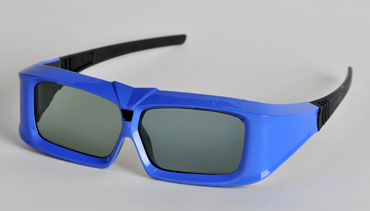3D Glasses: Can They Have Universal Appeal? Page 2

Behind the Shades
To create a successful 3D image, each eye needs to receive its own separate image - or actually, a slightly different angle of the same image. Our brain then processes the two images and derives a sense of depth from the distances. One of the toughest parts of the process is syncing the sequential opening and closing of the active LCD shutter glasses - done by applying voltage to the liquid crystals, just like an LCD TV - with the onscreen 3D content, so that one eye's view is blocked when the other receives an image. If the glasses don't respond quickly enough, or don't go completely opaque or transparent, images meant for one eye can bleed into the other, causing crosstalk (ghosting), flicker, blurring, or other picture anomalies.
Complicating the matter for third-party eyewear makers is that so far there are no 3D sync protocol standards, so universal 3D glasses must be able to work with the growing array of proprietary protocols used by the TV manufacturers. That's been the biggest challenge for XpanD, according to the company's chief strategy officer Ami Dror. "The protocols are like a language, and Panasonic is speaking Chinese and Sony is speaking Swedish," he says. "That requires us to speak multiple languages." Because XpanD's has been making eyewear for cinemas for years - it's the dominant player in Japan and parts of Europe, where most theaters use active-shutter glasses, not passive models - XpanD's 3D TV glasses "actually outperform the models offered by the manufacturers," Dror says.
According to Dror, a specialized fast-switching liquid crystal cell, called the "pi-cell," in the lenses of its active-shutter glasses helps to produce brighter images and reduce crosstalk (ghosting). The cells act as a shutter to alternately block each eye, operating at the 144 frames-per-second rate required for 3D digital cinema. The glasses are essentially in a continual sleep mode; about every two seconds they search for an IR signal, and if one is recognized the glasses "wake up" and lock onto the signal. Dror says that many of the complaints about 3D - headaches, nausea, etc. - occur when either a 3D TV or 3D glasses doesn't perform properly. "The brain can sustain bad 2D - the loss of little resolution, some pixelization or missing frames - but it's not as tolerant with bad 3D."
XpanD initially intended to ship its X103 universal 3D glasses at the end of June, but postponed the launch to include sync codes for Sony's recently released 3D TVs, as well as those arriving from LG Electronics this month. The software can be updated as new codes are released. The X103 glasses, available in September for $129, will work with almost any display - including plasma, LCD and rear-projection DLP microdisplays, as well as PC monitors - that can show 120-frames-per-second 3D content. Although the X103 glasses are sleeker than most OEM models and available in a choice of several colors, an even sleeker elite designer series, called the X104, will be offered in 2011 for more fashion-conscious users. A kids-sized line is also in the works.
- Log in or register to post comments




















































